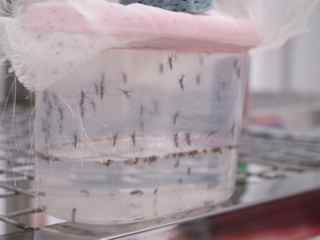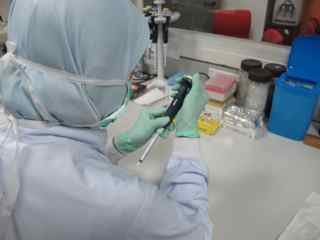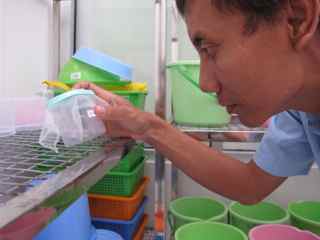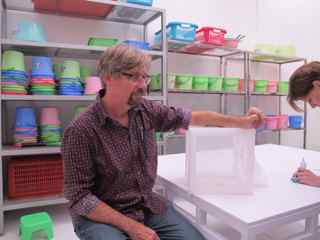Hungry mosquitos float out into the steamy air as soon as Sularto snaps open the container lid. Blowing the insects gently on their way, as gently as he might blow on a spoonful of hot soup, the stocky Indonesian waits for a minute before hitching his denim bag more securely onto his shoulder and setting off to the next release point.
His bag is filled with more plastic containers of mosquitos: today Sularto will release some 1,650 of these mosquitos, carefully bred by researchers from the multimillion dollar Australian-led Eliminate Dengue program. Freed in 33 different precisely-mapped locations here in Sleman district, adjacent to the city of Yogyakarta in Indonesia, these descendants of Australian mosquitos will soon begin to feed and it’s hoped, breed. A few of the mosquitos settle on Sularto’s back, hitching a ride onwards.
Other teams of field researchers are also at work introducing these mosquitos to pre-arranged sites in this sub-district of small-holdings; a place alive with scratching chickens, a flustered turkey and roving bands of inquisitive children.
 Mosquitos are mostly noxious in Indonesia, carrying the killer diseases of malaria and dengue fever and welting uncovered skin with ferociously itching bites. Tiny, droning, blood-sucking, ever-replicating, these potential carriers of intense pain and even death are a daily concern. But Sularto and his colleagues, accompanied by a village chief, are everywhere met with friendly greetings and broad smiles. These particular mosquitos are strangely welcome.
Mosquitos are mostly noxious in Indonesia, carrying the killer diseases of malaria and dengue fever and welting uncovered skin with ferociously itching bites. Tiny, droning, blood-sucking, ever-replicating, these potential carriers of intense pain and even death are a daily concern. But Sularto and his colleagues, accompanied by a village chief, are everywhere met with friendly greetings and broad smiles. These particular mosquitos are strangely welcome.
The people of Kronggahan II subdistrict have been told these mosquitos are not only guaranteed free of disease, they are the crucial bearers of the bacteria ‘wolbachia’. A mosquito infected with wolbachia bacteria is effectively disarmed – although it will still bite and probe human skin for blood, it can longer transmit the dengue virus from human to human. And best of all, these infected mosquitos pass the neutralising wolbachia bacteria on to future generations of mosquitos, eventually rendering entire populations harmless.
Dengue-carrying mosquitos, mostly of the species aedes aegypti, prefer urban environments. They bite by day and they are prolific breeders; their eggs can hatch in tiny amounts of still water – producing live larvae in the upturned lid of a soft-drink bottle. Rarely living for more than 30 days, or moving more than a couple of hundred metres from where they were hatched, they seem infinitely adaptable.
Indonesians live with dengue as an ever-present danger: there were 3,335 cases of dengue in Yogyakarta province alone last year; 18 of them fatal. Despite decades of research, no vaccination exists for dengue, and there is no cure. A brutal disease, it is characterised by fevers, thumping pain behind the eyes, muscle and joint pains, vomiting, swollen glands and a rash. Severe dengue usually includes savage abdominal pain and persistent vomiting, and it can lead to severe bleeding, organ damage and death.
Pushed along by the warmer and wetter conditions of climate change, dengue is rapidly advancing on many fronts around the world. The World Health Organisation estimates there now may be as many as 100 million dengue infections worldwide every year. Anything that can do battle with dengue, sometimes known as ‘breakbone fever’, is worth a shot, even it means introducing more mosquitos.
 “I’m not worried, neither are the people,” says village chief Anto Sudadi, merrily hailing his constituents as he walks along beside Sularto (like many Indonesians, Sularto only has one name). Sudadi pauses as another load of super-mosquitos is released. “Dengue is endemic here. This is something we can do: get more mosquitos with wolbachia. Hopefully they will reach the others.”
“I’m not worried, neither are the people,” says village chief Anto Sudadi, merrily hailing his constituents as he walks along beside Sularto (like many Indonesians, Sularto only has one name). Sudadi pauses as another load of super-mosquitos is released. “Dengue is endemic here. This is something we can do: get more mosquitos with wolbachia. Hopefully they will reach the others.”
Later, sitting on the floor in Sudadi’s house, dubbed “base camp” by the Eliminate Dengue team, snacking on rambutan and fried banana, the field workers seem relaxed and relieved. Nothing had gone wrong with this day’s planned mosquito releases; no problems, no disputes with the locals who distrust this Australian research. One section of the field workers’ maps is blocked out, striped in red. It’s a “no release” area, a few small blocks where the residents are hostile to the idea of mosquito introduction and where there’s always the potential for confrontation.
After two years of consultation, the vast majority (94 per cent) of the thousands of residents in this subdistrict agreed to the mosquitos’ introduction and signed the relevant consent forms. Yet there are some stubborn hold-outs in one small section of Kronggahan, and a couple of hundred who have swung back, withdrawing their consent, galvanised, perhaps, by the passions of a couple of leaders. “It’s not many, maybe one or two people, but they influence others,” Sudadi says comfortably. “People listen to them.”
Ahmad Mar’uf is one opponent who has been widely quoted in the Indonesian press, asserting the people of Kronggahan were not properly informed about the trial, that new cases of dengue fever have been documented since the mosquito releases, and that Indonesians should not be used as “kelinci” or guinea pigs for these trials with “Australian” mosquitos.
True, the ancestors of these aedes aegypti mosquitos released in Kronggahan were Australian. At least 10,000 mosquito eggs were imported from Australia in September 2012 for these releases, which began in January and will continue weekly for a few months. But since those imported eggs hatched, the adults have been crossed and re-crossed and re-crossed again with Indonesian mosquitos to make them as similar as possible to the local insects, with similar insecticide tolerance levels. The mosquitos released in Kronggahan are perhaps 2 per cent Australian.
Opponents of the research met with Eliminate Dengue team members on various occasions and complained that residents hadn’t been given enough information and they hadn’t been given a written contract detailing researchers’ responsibilities. They asked about financial compensation in case something went wrong. Finally they stopped talking to anyone in the team.
 Yogyakarta’s renowned Gajah Mada University is technically the leader of the Indonesia-funded Eliminate Dengue project in Yogyakarta. Professor Adi Utarini, vice dean in the university’s medical faculty, says she almost expected some in the community to refuse to take part in the research. “Some of them, at first they agreed, and then they disagreed,” she says ruefully. “Maybe we weren’t clear in informing them that the trial is not the first trial in the world. Even if they were informed about that, maybe they still feel they are ‘guinea pigs’ because it is the first trial in Indonesia.” Still, she hasn’t given up on the backsliders, and says they will be again asked if they would like to cooperate.
Yogyakarta’s renowned Gajah Mada University is technically the leader of the Indonesia-funded Eliminate Dengue project in Yogyakarta. Professor Adi Utarini, vice dean in the university’s medical faculty, says she almost expected some in the community to refuse to take part in the research. “Some of them, at first they agreed, and then they disagreed,” she says ruefully. “Maybe we weren’t clear in informing them that the trial is not the first trial in the world. Even if they were informed about that, maybe they still feel they are ‘guinea pigs’ because it is the first trial in Indonesia.” Still, she hasn’t given up on the backsliders, and says they will be again asked if they would like to cooperate.
Dengue research is vital in Indonesia, where most people have lived through a bout of the disease at least once before they turn 18. Professor Adi herself has had dengue twice and she is committed to the wolbachia trials. “We know from other programs that a vaccine alone will not give us the desired result,” she says, adding that attempts to blast mosquitos out of existence with insecticides carry their own environmental hazards.
The global Eliminate Dengue program is led by Dr Scott O’Neill; an Australian entomologist, the dean of science at Monash University, and a man who is mightily frustrated by the unexpected opposition thrown up by Mar’uf (apparently an economist with another university in Yogyakarta) and friends. Explaining that both the Sultan of Yogyakarta and the Yogyakarta government had advised the Eliminate Dengue team to play it cool until there were some actual results to announce, he says there was no launch or formal announcement of the project and Mar’uf’s statements to the press took everyone by surprise. It was a masterful opposition strategy.
“We haven’t encountered it before,” O’Neill says. “This was a very vocal minority of people in one area who started to get into the media and so forth about the trial and we were disappointed – there was a bit of misinformation. By and large, we’ve had huge community support. People are quite fearful of dengue, and they appreciate that there’s no real treatment and no way to bring it under control at the moment.”
Mar’uf and friends, via Indonesian legal aid, finally sent a legal letter of demand to the Eliminate Dengue team to stop releasing mosquitos near their homes (releases had never actually started in the opponents’ area so it was an easy demand to comply with). O’Neill says Gajah Mada leaders were not impressed and countered that in fact these opponents should be careful: they could be prosecuted for trying to block a project with benefits for the people of Kronggahan. The warning shot seems to have worked. Nothing has been heard from them since.
Born of largely Australian research, the multi-million dollar Eliminate Dengue program has already notched up notable successes with wolbachia bacteria. After seven trials, wolbachia-infected mosquito populations have now been established in small districts in far north Queensland, where dengue has again erupted this summer. At least 125 cases have been confirmed in and around Cairns and Innisfail, 17 around Port Douglas and 10 in Townsville and surrounds, but, encouragingly, there have been no clusters of confirmed cases in the Cairns trial sites.
 Trials in Asia were the obvious next step. Trials in Vietnam last year were a disappointment: that particular wolbachia strain – “wMelPop”, although a superb dengue blocker, inhibited the mosquitos’ breeding and the colonies failed. But there will be another trial in Vietnam this year with the easier to establish “wMel” strain, and more trials in Yogyakarta and northern Queensland, looking for that elusive sweet spot somewhere between “wMelPop” and “wMel”, the strain with the perfect combination of dengue-blocker and longevity.
Trials in Asia were the obvious next step. Trials in Vietnam last year were a disappointment: that particular wolbachia strain – “wMelPop”, although a superb dengue blocker, inhibited the mosquitos’ breeding and the colonies failed. But there will be another trial in Vietnam this year with the easier to establish “wMel” strain, and more trials in Yogyakarta and northern Queensland, looking for that elusive sweet spot somewhere between “wMelPop” and “wMel”, the strain with the perfect combination of dengue-blocker and longevity.
The next big wolbachia trial is scheduled for Rio de Janeiro in July and there are plenty of candidates clamouring for trials stretching into the future, including requests from Queenslanders living outside the trial sites. Colombia is in the queue and Costa Rica. “Yeah, we’re getting that, not just in Cairns, but around the world,” O’Neill says with a grin. “The Philippines is pushing hard, and there are individuals who would like to have it around their houses. There’s even a request from Costa Rica to introduce them around a hotel. So, yeah, there’s a lot of interest, the problem is trying to manage that interest, and not try and do too much too quickly.”
Scientists around the world are also watching the Eliminate Dengue wolbachia trials with great interest. Charitable foundations, notably the Bill and Melinda Gates Foundation, and, in Indonesia, the Yayasan Tahija, help fund various Eliminate Dengue trials. Along with various government organisations they have hurled billions of dollars into the fight against dengue and malaria.
“We’ve got our hands quite full with dengue at the moment, but there are other groups around the world developing the malaria story,” O’Neill says. “It’s a more complicated situation, because there are many different types of mosquitos around the world that transmit malaria. But still, I think the approach has quite a lot of promise for malaria, and also other mosquito transmitted diseases like yellow fever and Japanese encephalitis.”
 With this ever-building social and scientific support, optimists might see the opposition in Indonesia, however vocal, as a minor rumble on the way to bright and shining success: international acceptance that wolbachia bacteria will eventually rid the world of dengue. It could be a Jonas Salk polio vaccine moment, or it might have the resonance of Ian Frazer’s HPV discoveries. Yet there won’t be a single revolutionary thinker to credit with the victory, if it works out that way.
With this ever-building social and scientific support, optimists might see the opposition in Indonesia, however vocal, as a minor rumble on the way to bright and shining success: international acceptance that wolbachia bacteria will eventually rid the world of dengue. It could be a Jonas Salk polio vaccine moment, or it might have the resonance of Ian Frazer’s HPV discoveries. Yet there won’t be a single revolutionary thinker to credit with the victory, if it works out that way.
The Eliminate Dengue effort has many parents but O’Neill is prominent among them. An easy-going Australian scientist with a shock of grey hair and a disarming smile, he spends a lot of time trundling around the world on various Eliminate Dengue projects. “I am a believer,” he says with conviction. “I definitely think it’s going to work.”
With the cane toad looming large in the national psyche, many Australians believe that messing with nature can be a perilous undertaking. O’Neill marshals his arguments to shoot down the doubters.
“Wolbachia is not a foreign organism to any country in the world,” he says firmly. “It occurs naturally in around 70 per cent of all insect species, including bees, ants and butterflies, so it’s a natural organism in the environment already, not something we’re introducing. We’ve done a lot of independent risk analysis on this project. Other experts, including the CSIRO, have looked at it very carefully. The conclusion is that the risk of environmental consequences is negligible.”
Other entomologists aren’t quite so convinced of the sweeping powers of wolbachia, but the bacterium is generally regarded as a potentially useful weapon in the anti-dengue armoury and one that might in the future be successfully deployed in combination with an effective vaccine – when a vaccine is finally found.
The quest for a potential dengue vaccine has been underway for decades with no real success. Now, according to the World Health Organisation, a commercial vaccine from Sanofi Pasteur is in phase three trials and results are expected by the end of this year. But some scientists are openly doubtful whether this particular vaccine will reach the final hurdle.
Professor Cameron Simmons, a recognised dengue expert with appointments at both Oxford and Melbourne universities, notes that the phase two trials of this vaccine were “ultimately disappointing” and only emerged after the massive phase three trial – with 30,000 participants – had begun. Even if the vaccine soars through the phase three trial, it will prove difficult to administer, requiring three doses six months apart.
Dengue is tricky. There are four known serotypes (or species variations) of the dengue virus (DEN 1 to 4) and each is capable of causing dengue. A vaccine must prompt an immune response to all four types. Although recovery from one type of dengue provides lifelong immunity against that particular serotype, it also opens the way for a “severe dengue” infection from another serotype. So if you have already had dengue, it could be far worse – or fatal – the second time round.
Simmons takes the long view. “There’s not going to be a single answer for dengue,” he says. The likely best way to eliminate dengue, he says, will be with a vaccine – even if it’s only partially effective – used in combination with wolbachia and perhaps other interventions that the world knows can work if sufficient time and money are spent on them. “But there won’t be one magic bullet that sorts out dengue globally in the next decade.”
Back in the Eliminate Dengue headquarters on the campus of Gadjah Mada university in Yogyakarta, a small building with a large insectary and a sophisticated lab for testing insect DNA, O’Neill settles into a chair in front of a container alive with mosquitos. He rolls up his sleeve to rest his bare arm on a plastic container’s netted circular inlet. Some 300 mosquitos rev into action, zeroing in on his unprotected flesh. He bears it without wincing: there are some sacrifices entomologists just have to make. After about 15 minutes he lifts his arm and looks at the circular patch of skin covered with tiny bites that will swell into welts within minutes.
Recruited for this session by the Indonesian entomologist running the bug crèche, Dr Warsito Tantowijoyo, O’Neill is a temporary ring-in on the roster of Eliminate Dengue team members drafted in to feed the mosquitos, providing the blood needed to keep them alive and encourage them to breed. Like O’Neill, Warsito feeds the mosquitos with his own blood, and they thrive.
A time-consuming and itchy exercise, human blood-feeding is essential. Only the females drink blood: they need it to produce eggs. The insectary’s blood volunteers are strictly vetted before each session – they must not be taking antibiotics, they must have no fever and feel no pain behind the eyes, and they must feel no fatigue (potential signs of dengue: the mosquitos must be kept absolutely disease-free). Warsito says it’s important to have many generations of mosquitos on hand to monitor their well-being. “We need to be able to predict the life cycle,” he says, “we’re trying to control an uncontrolled animal.”
City-wide trials of wolbachia are slated for Townsville later this year and Yogyakarta in 2017, and the Eliminate Dengue team is considering cost-effective methods for the mass introduction of wolbachia mosquitos. Luckily for the squeamish, hand-feeding (or arm-feeding) adult mosquitos won’t work for big trials: the scale would be unmanageable. Mosquito eggs, which can remain viable for months without water, combined with ordinary plastic buckets – perhaps provided to schools throughout the city – could be one inexpensive option that doesn’t require scientists or lab attendants to make it work.
Whichever method finally chosen, O’Neill will tread carefully, worried about far-reaching consequences. After all, wolbachia could potentially save many thousands of lives around the world each year. Large and expensive trial failures might erode much needed support. “We only want early wins,” he says. “We’re really scared about going too fast and then tripping.”
All photos by Sian Powell
http://www.smh.com.au/national/health/the-mosquito-solution-20140505-37r6k.html